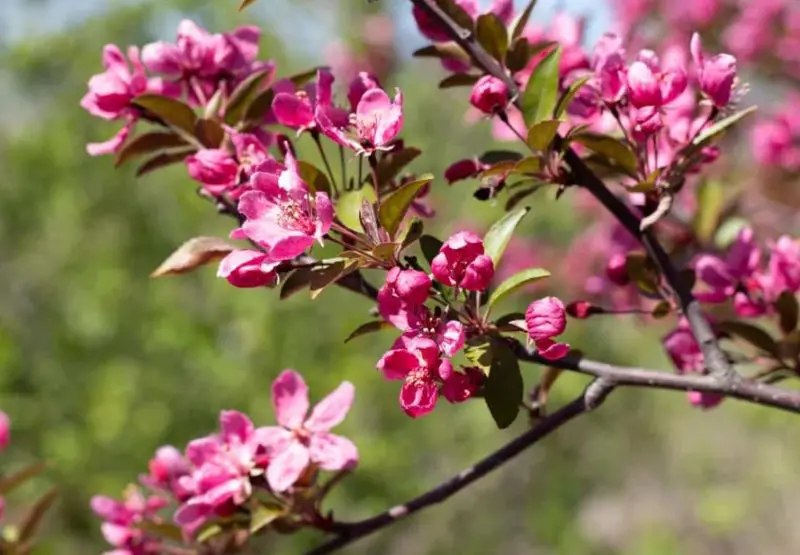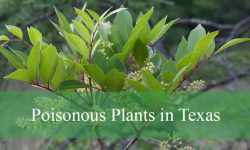The Prairifire Crabapple Tree (Malus ‘Prairifire’) is a stunning ornamental tree that has gained popularity among gardeners and landscapers due to its vibrant blossoms, remarkable disease resistance, and year-round aesthetic appeal.
This tree is particularly valued for its ability to provide visual interest throughout all four seasons. In spring, it bursts into a profusion of pinkish-red blossoms, attracting pollinators like bees and butterflies. As the seasons progress, its foliage transitions from a deep reddish-bronze to a rich dark green in summer, then turns to shades of orange and red in autumn, creating a spectacular display.
Even in winter, the tree remains attractive due to its dark red to purple fruit, which persists on the branches and provides a food source for birds. This guide offers a comprehensive overview of everything you need to know about planting, growing, and caring for the Prairifire Crabapple Tree to ensure it thrives in your landscape.
Characteristics of the Prairifire Crabapple Tree

Appearance
The Prairifire Crabapple Tree is known for its compact yet spreading growth habit, making it an excellent choice for small to medium-sized gardens. It typically reaches a mature height of 15 to 20 feet with a similar spread, providing a balanced and symmetrical canopy.
During the growing season, its foliage undergoes a remarkable transformation. When the leaves first emerge in spring, they display a striking reddish-bronze hue. As summer approaches, they mature into a deep green color, offering a lush and healthy appearance.
The flowers of the Prairifire Crabapple are one of its most notable features. In early to mid-spring, before the foliage fully develops, the tree becomes covered in an abundance of vibrant pinkish-red blossoms. These flowers not only create a visually stunning effect but also serve as an important nectar source for bees and butterflies.
After the blossoms fade, small, dark red to purple fruits begin to form. These fruits, measuring around half an inch in diameter, persist on the tree well into winter, adding to its ornamental value and attracting birds.
The tree’s bark is another attractive feature, with a dark reddish-brown hue and a slightly textured appearance that provides additional visual interest, particularly in the winter months when the tree has shed its leaves.
Growth Rate
The Prairifire Crabapple Tree exhibits a moderate to fast growth rate, typically gaining between one to two feet in height per year under optimal growing conditions. It usually reaches full maturity within 10 to 15 years.
This relatively quick growth makes it an excellent choice for those looking to establish a mature-looking landscape within a reasonable time frame. The tree’s robust growth habit also ensures that it remains strong and resilient against various environmental stressors.
Hardiness Zone
This tree thrives best in USDA hardiness zones 4 to 8, making it suitable for a wide range of climates. It is highly adaptable to cold temperatures, allowing it to withstand harsh winter conditions in northern regions.
Additionally, once established, it exhibits moderate drought tolerance, making it a reliable choice for areas that experience occasional dry spells.
Wildlife Attraction
The Prairifire Crabapple Tree plays a crucial role in supporting local wildlife. During its blooming period, the tree attracts numerous pollinators, including bees and butterflies, which benefit from its abundant nectar supply.
In the fall and winter months, the persistent fruit provides a vital food source for birds, including robins, cedar waxwings, and finches. By planting this tree in your garden, you can contribute to a healthier ecosystem by offering sustenance to these beneficial creatures throughout the year.
How to Grow a Prairifire Crabapple Tree
Choosing the Right Location
Selecting an appropriate planting site is essential for ensuring the long-term health and growth of your Prairifire Crabapple Tree. This tree thrives in locations that receive full sun, meaning it should be exposed to at least six to eight hours of direct sunlight each day.
Sufficient sunlight is crucial for promoting abundant flowering and healthy foliage development. Additionally, the soil should be well-drained and loamy, although the tree can adapt to various soil conditions. It performs best in slightly acidic to neutral soil with a pH range of 6.0 to 7.0.
When determining the placement of your tree, it is important to consider its mature size. Ensure that there is enough space for the tree to spread, allowing for at least 15 to 20 feet of distance from other trees or structures. Proper spacing promotes good air circulation, reducing the risk of fungal diseases.
Planting Steps
To plant your Prairifire Crabapple Tree successfully, begin by digging a hole that is twice as wide as the root ball and just as deep. This allows the roots to spread easily and establish themselves in the soil.
Before placing the tree in the hole, amend the soil by mixing in compost or organic matter to improve drainage and fertility. Position the tree in the hole so that the top of the root ball is level with the surrounding soil surface. Backfill the hole with soil, gently tamping it down to remove air pockets.
Once planted, water the tree deeply to encourage root establishment. Applying a two to three-inch layer of mulch around the base of the tree will help retain moisture and suppress weed growth. However, avoid placing mulch directly against the trunk to prevent rot.
Prairifire Crabapple Tree Care
Watering
Proper watering is essential, especially during the first year after planting. Newly planted trees should be watered deeply once or twice a week, ensuring that the soil remains consistently moist but not waterlogged.
Once the tree is established, it requires watering every 10 to 14 days during dry periods. Overwatering should be avoided, as excessive moisture can lead to root rot and other fungal issues.
Fertilization
Fertilizing your Prairifire Crabapple Tree helps promote vigorous growth and abundant flowering. The best time to apply fertilizer is in early spring before new growth begins.
A balanced, slow-release fertilizer with an equal ratio of nitrogen, phosphorus, and potassium, such as 10-10-10 or 14-14-14, is recommended. Spread the fertilizer evenly around the drip line of the tree, taking care to avoid direct contact with the trunk. Watering after application helps the nutrients penetrate the soil effectively.
Pruning
Pruning is an important aspect of maintaining the health and appearance of your Prairifire Crabapple Tree. The best time to prune is in late winter or early spring before new buds break.
Start by removing any dead, damaged, or diseased branches. Additionally, thin out crowded areas within the canopy to improve air circulation and light penetration. Regular pruning helps maintain the tree’s shape and prevents the development of weak or crossing branches.
Disease and Pest Control
The Prairifire Crabapple Tree is known for its strong resistance to many common apple tree diseases. However, in excessively wet conditions, it may still be susceptible to apple scab, fire blight, or powdery mildew.
Regular pruning and ensuring proper airflow around the tree can help prevent these issues. Common pests such as aphids, Japanese beetles, and scale insects can occasionally pose a problem. Using insecticidal soap, neem oil, or introducing beneficial insects like ladybugs can help control pest populations effectively.
Conclusion
The Prairifire Crabapple Tree is a fantastic choice for any landscape, offering stunning blooms, vibrant foliage, and a wealth of benefits for local wildlife.
With proper care, including correct planting, watering, fertilization, and pruning, this tree will thrive and provide beauty throughout the seasons. Whether used as a focal point in a garden or as part of a pollinator-friendly landscape, the Prairifire Crabapple Tree is a rewarding and low-maintenance addition to any outdoor space.






